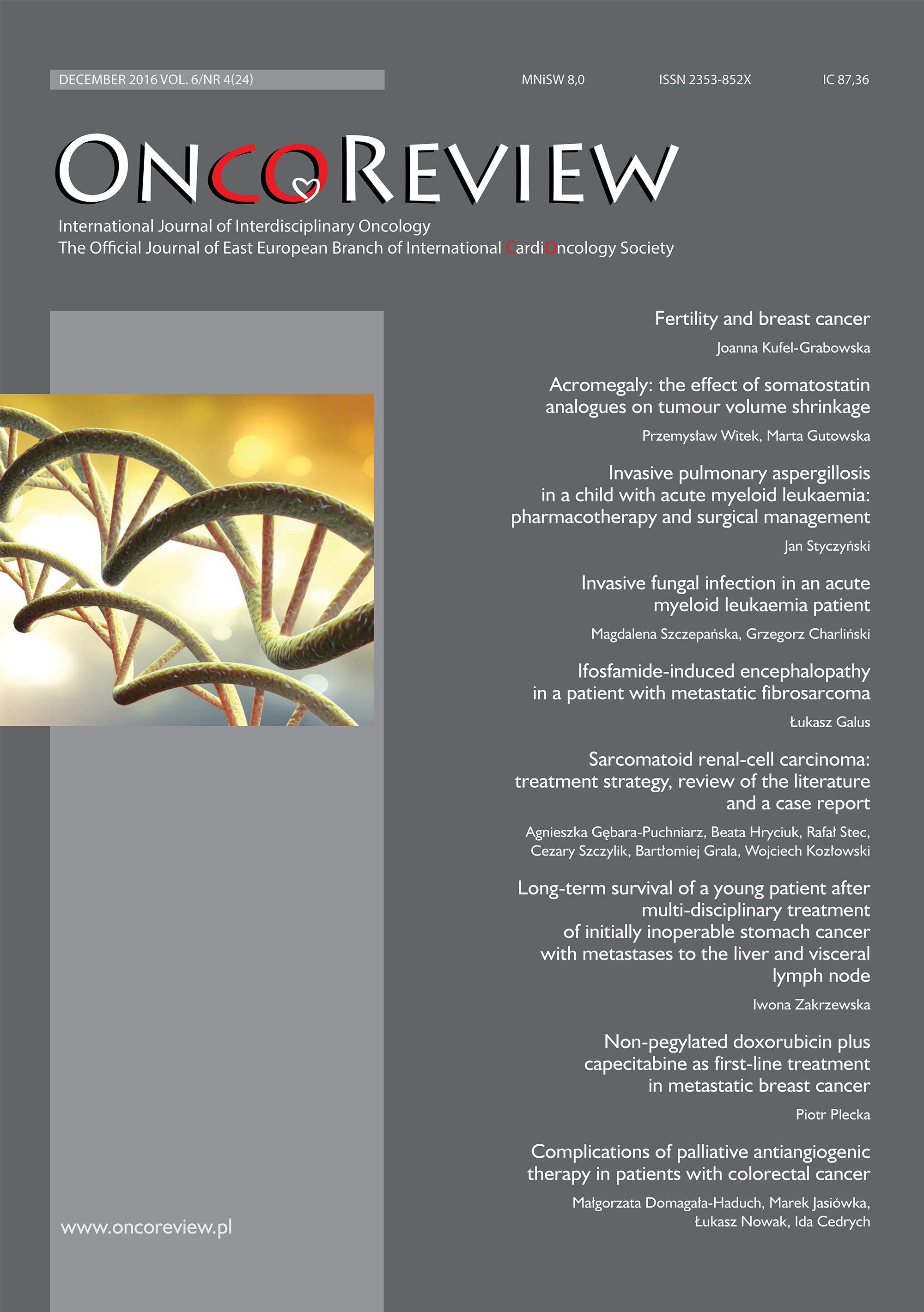Mięsakowaty rak nerkowokomórkowy: strategia leczenia, przegląd literatury i opis przypadku Case report
##plugins.themes.bootstrap3.article.main##
Abstrakt
Wstęp: Mięsakowaty rak nerkowokomórkowy jest bardzo rzadkim nowotworem o agresywnym przebiegu i złym rokowaniu. Do tej pory nie zostały opracowane standardy postępowania w tym podtypie histologicznym raka nerki ze względu na jego oporność na różne formy leczenia systemowego.
Metody: Przedstawiamy przypadek 58-letniej kobiety po lewostronnej nefrektomii z powodu raka jasnokomórkowego z komponentem sarkomatycznym oraz prawostronnej nefrektomii z powodu synchronicznego raka jasnokomórkowego. W I linii leczenia pacjentka otrzymała bewacyzumab i temsirolimus w ramach badania klinicznego. W II linii zastosowano terapię skojarzoną gemcytabiną z doksorubicyną, a w III – ifosfamid. U chorej wykonano dwukrotnie resekcję zmian przerzutowych w płucach i raz – resekcję przerzutów w wątrobie.
Wnioski: Leczenie chirurgiczne (w tym metastazektomia) z następowym leczeniem systemowym wydaje się właściwym postępowaniem terapeutycznym w raku nerki z komponentem mięsakowatym. Opracowanie optymalnego schematu terapii systemowej wymaga dalszych prospektywnych, randomizowanych badań klinicznych.
Pobrania
##plugins.generic.paperbuzz.metrics##
##plugins.themes.bootstrap3.article.details##

Utwór dostępny jest na licencji Creative Commons Uznanie autorstwa – Użycie niekomercyjne 4.0 Międzynarodowe.
Copyright: © Medical Education sp. z o.o. This is an Open Access article distributed under the terms of the Attribution-NonCommercial 4.0 International (CC BY-NC 4.0). License (https://creativecommons.org/licenses/by-nc/4.0/), allowing third parties to copy and redistribute the material in any medium or format and to remix, transform, and build upon the material, provided the original work is properly cited and states its license.
Address reprint requests to: Medical Education, Marcin Kuźma (marcin.kuzma@mededu.pl)
Bibliografia
2. Haas NB., Lin X, Manola J et al. A Phase II Trial of doxorubicin and gemcitabine in renal cell carcinoma with sarcomatoid features: ECOG 8802. Med Oncol 2012; 29(2): 761-767. https://doi.org/10.1007/s12032-011-9829-8.
3. Dutcher JP, Nanus D. Long-term survival of patients with sarcomatoid renal cell cancer treated with chemiotherapy. Med Oncol 2011; 28(4): 1530-1533. https://doi.org/10.1007/s12032-010-9649-2.
4. Staehler M, Schoppler G, Haseke N et al. Sorafenib is superior to combination therapy with gemcitabine plus doxorubicin for patients with sarcomatoid renal cell carcinoma. Presented at the 2008 American Society of Clinical Oncology Genitourinary Cancer Symposium. San Francisco, California, February 14–16, 2008.
5. Staehler M, Haseke N, Roosen A et al. Sorafenib after combination therapy with gemcitabine plus doxorubicin in patients with sarcomatoid renal cell carcinoma: A prospective evaluation. Eur J Med Res 2010; 15(7): 287-291 https://doi.org/10.1186/2047-783X-15-7-287.
6. Golshayan AR, George S, Heng DY et al. Metastatic sarcomatoid renal cell carcinoma treated with vascular endothelial growth factor- targeted therapy. J Clin Oncol 2009; 27: 235-241.
7. Krzakowski M, Dziadziuszko R, Fijuth J et al. Zalecenia postępowania diagnostyczno-terapeutycznego w nowotworach złośliwych. 2013; 1: 369-377.
8. Cheville JC, Lohse CM, Zinke H et al. Sarcomatoid renal cell carcinoma: an examination of underlying histologic subtype and an analysis of associations with patient outcome. Am J Surg Pathol. 2004; 28(4): 435-441.
9. Nanus DM, Garino A, Milowsky MI et al. Active chemotherapy for sarcomatoid and rapidly progressing renal cell carcinoma. Cancer 2004; 101: 1545-1551.
10. Motzer RJ, Mazumdar M, Bacik J et al. Survival and prognostic stratification of 670 patients with advanced renal cell carcinoma. J Clin Oncol 1999; 17: 2530-2540.
11. Michaleson MD, McKay RR, Werner L et al. Phase 2 trial of sunitinib and gemcitabine in patients with sarcomatoid and/or poor-risk metastatic renal cell carcinoma. Cancer 2015; 121(19): 3435-3443. https://doi.org/10.1002/cncr.29503.

